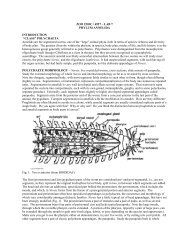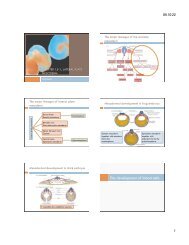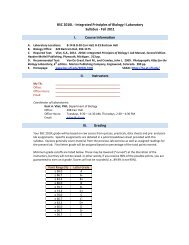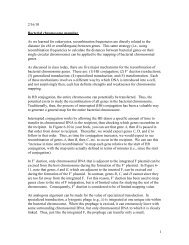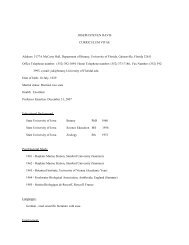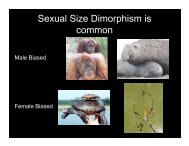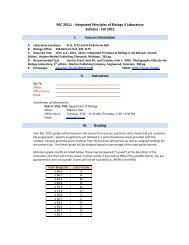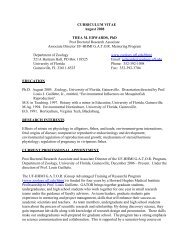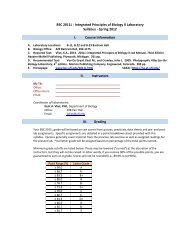Lecture Notes 7: Annelida
Lecture Notes 7: Annelida
Lecture Notes 7: Annelida
Create successful ePaper yourself
Turn your PDF publications into a flip-book with our unique Google optimized e-Paper software.
- palps antenniform, + 1-3 antennae = 3-5 similar tentacles on head<br />
- pair of peristomial cirri on peristomium behind prostomium – unique to Eunicidae-Onuphidae<br />
- rowing raptorial omnivores w/ jaws on ventral pad pharynx<br />
Amphinomidae<br />
- fire worms; calcified chaetae with venom<br />
- caruncle<br />
- rowing predators; especially striking in tropics<br />
Polynoidae<br />
- scale worms; elytra arising from dorsal side of alternate notopodia<br />
- lack well developed dorsal cirri on scale-bearing segments; though not clear homology between cirri and elytrae<br />
- rowing predators and symbionts<br />
Glyceridae – carnivore, especially of crustaceans<br />
- Glycera lives in burrow system with multiple entrances, sitting near base of branches, feeling for vibrations with 4<br />
prostomial tentacles and also by chemoreception. Moves up into appropriate burrow to capture prey, via<br />
eversible, pharynx armed with 4, hollow, venomous fangs. Venom glands. Especially crustacean predator<br />
- lack septae in anterior ~20 segments to accommodate huge eversible pharynx<br />
Nereididae<br />
- prostomium with paired antennae, palps, peristomium reduced, first segment compound with multiple tentacular<br />
cirri<br />
- errant, temporary mucus tube, herbivorous, some carnivory, scavenging<br />
- paired large jaws in large eversible pharynx look formidable, but mostly used for pulling algae into gut.<br />
Platynereis farms Ulva, attaching it to tube, cutting off pieces and in turn attaching those to tube and grazing on<br />
growth. In winter, when no Ulva, switches over to eating diatoms<br />
PALPATA – CANALIPALPATA<br />
Sabellidae<br />
- prostomium largely transforms into radiolar crown, which developmentally is homologous to prostomial palps,<br />
and seen as arising as such in larvae<br />
- ciliary feeding, tentacles with three sets of channels: food, tube-building grains, reject channel<br />
- thorax (usually 8 segments) and abdomen, with chaetal inversion<br />
- dorsal thoracic and ventral abdominal fecal groove<br />
Serpulidae<br />
- like Sabellidae, but calc tube<br />
- Spirobranchinae within it – tiny, spiral worms that brood, direct dev, ubiquitous<br />
Chaetopteridae<br />
- in parchment tubes, either U shaped or straight down<br />
- some with paired feeding palps, some lost it<br />
- major body tagmatization: arms to secrete mucus bag, cup to hold it, major notopodial paddles to drive current<br />
- mucus bag feeding, can get tiny particles<br />
Spionidae<br />
- some of the most abundant polychaetes, enormous densities<br />
- tube dwelling, tiny, paired feeding palps, can be used for deposit or suspension feeding or both<br />
Terebellidae<br />
- spaghetti worms – multiplied palps give spaghetti effect<br />
- palps with ciliary track for carrying food; walk out with it upside down





